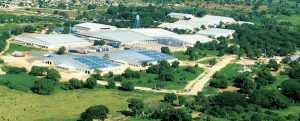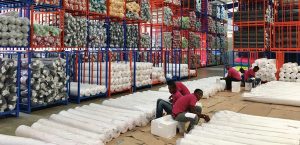
Haiti-based CODEVI industrial park has moved from a vision to the largest employer in the country’s northern region.
By Mike Todaro
Fernando Capellan had a vision that he might be able to build a unique industrial park in Haiti. His vision became a reality and the Compagnie de Développement Industriel S.A. (CODEVI) industrial park in Ouanaminthe, Haiti, on the Dominican Republic border now encompasses 17 buildings, with more in the works.
CODEVI is owned by Capellan’s Grupo M, a private apparel manufacturer founded in 1986. The Dominican Republic-based company is vertically integrated and produces knits and woven products for the U.S. market. Capellan opened CODEVI in August 2003. It remains the biggest socioeconomic project in the area and the largest employer in the country’s northern region.
But it wasn’t easy for Capellan to realize his vision. Haiti and the Dominican Republic are different countries and cultures with almost no history of industrial collaboration. Each nation has a population of approximately 10 million people. Haiti itself is among the low cost countries of the world. The industry added to that competitive advantage with trade laws and Free Trade Agreement’s such as the Haiti Economic Lift Program (HELP) Act and the Haitian Hemispheric Opportunity through Partnership Encouragement (HOPE) Act that granted use of foreign fabric and duty-free access to the United States, Europe and Canada and of course proximity. Port-au-Prince became the epicenter of factories in Haiti until CODEVI.
The construction project ran into standard issues encountered when starting a business in a foreign country including legal framework, identifying a location for the installation, financing, infrastructure, construction, training and much more. Still, what drove the project was Capellan’s unwavering vision — one of a park that consolidated cost-competitive Haitian labor in quantity, was on the border, met Haitian law, combined Dominican expertise and was supported by modern infrastructure. It could export from a more modern and closer Dominican port such as Manzanillo, which is only 20 minutes away, and help to further reduce lead-times and logistics.
CODEVI Today
CODEVI started with 4-million-square-feet of land. In 2008, there were five buildings and 3,000 employees. As of 2017, the park has grown to feature 17 buildings and employs 10,000 people. Brands manufacturing at the park include Levi’s, GAP Inc., Under Armour, Hanes, Fruit of the Loom, Carhartt, and Jockey among other brands; and the owners of factories located in the park are global players based in the United States, Sri Lanka, and China, to name a few countries. These companies do not invest lightly. They commit for years by building a factory from scratch, from the ground up and for the long haul. That’s the vision part of this report.

“The starting point of the park was high,” said Joseph Blumberg, partner and senior vice president, marketing and new business, Grupo M. “We applied the proven formula of Grupo M, which is that compliance is in the DNA of everything we do.” Every detail of energy, training, social responsibility, environment, basic health, cooking, child education, transportation, safety and financial responsibility was considered 10,000 times — for every employee.
Take each employee. To be considered for hiring they must be able to read, write and perform basic math. In a country with more than 50 percent unemployment — and often much higher — competition for these jobs is high. When hired, each person receives three months of training at half pay and with full benefits. When hired, they can exceed 40-percent minimum wage with incentives.
When ground broke on the park in 2003, the area was extremely basic — hand-to-mouth with no formal economy. Today, the community is served by CODEVI’s radio and TV station that shows entertainment, educates and alerts the community to disease outbreaks. Additionally, back in 2003 none of the employees saved money. Today, more than 90 percent of CODEVI’s 10,000 employees participate in the park’s Savings and Loan Club.
Walking through the town of Ouanaminthe wearing a CODEVI badge is a sign of status. Capellan does not take full credit for the company’s success. “We believe that this success is due to the fact that the 10,000 employees identify with the work they do,” he said.
“Everyone has the opportunity to receive training and to improve his family’s quality of life.”
“We pick the companies who invest here carefully,” Blumberg said. However, it is clear the companies investing in the park see the potential. CODEVI is the only Dominican project in Haiti, and illustrates the value of the synergy each nation and its people bring to the table — motivated workers in a structured, highly efficient production center.
Finally, make no mistake, this is not just Dominicans and Haitians either. There may be more than a dozen nationalities working in multiple levels of management throughout the park. As a result, there is a collocated campus of apartments and even a hotel to support the traffic into the park. As for the park itself, it may soon grow from its current 4 million square foot size to nearly 10 million square feet in the future.
The expansion will include a MicroPark right across the bridge built to connect the park to the town. It will be a 600,000-square-foot town center featuring a vocational school, fully equipped clinic, food court, housing and recreational facilities. All of this is a part of a bigger picture being developed by the Quisqueya Economic Binational Council (CEBQ) with private sectors of both countries working side-by-side on a range of projects along the whole border to impact the economies and progress of both Haiti and the Dominican Republic.
Vision? Visions are pictures from the ends of albums of photos of other visions that hit the wall. As they say, it’s a dream until its put into writing, then it’s a plan. CODEVI was put into writing and Grupo M never changed a word of the plan because the plan was to “do it right from the start.”
Editor’s Note: Mike Todaro is the managing director of the Atlanta-based Americas Apparel Producers’ Network (AAPN). AAPN is a private sector, non-profit, members-only apparel industry business network of more than 600 company owners and senior executives from 200 companies across the apparel supply chain. Todaro thanks Capellan and Blumberg for the tour, and for Grupo M’s long-term membership and support of AAPN.
September/October 2017




